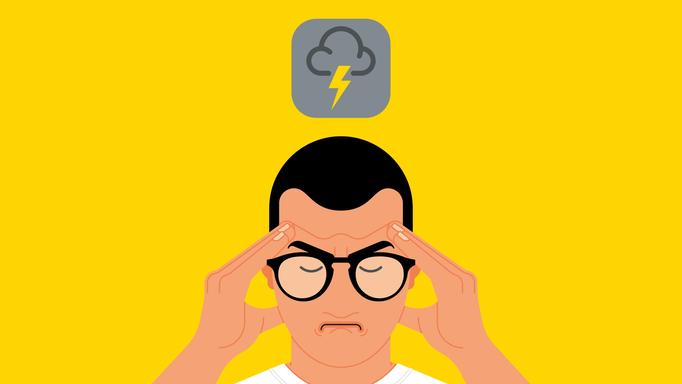
Last Thursday morning, like any normal person, I woke up and checked my phone: overnight emails, news alerts, friends bemoaning the pandemic, dog pictures from my uncle. And of course, the Weather Pain Forecast website for the area around my home in Tokyo.
According to the frowning, sweat-beaded orange icon on the screen, we were in for a bad day. Given the predicted confluence of barometric pressure change and temperature volatility, my headache would probably begin pounding solidly around 10am before peaking shortly after lunch and tailing off into the early evening. Friday would probably be fine. It is all strangely addictive, if not necessarily very accurate.
The premise of the Weather Pain Forecast is that day-to-day fluctuations in the weather can provoke headaches and joint aches, and heighten other miserable health issues such as arthritis. In order to be more useful, runs the argument, weather forecasting should attempt to incorporate the likelihood of physical pain in the daily outlook the way it already does with pollen counts for allergies.
The index went into operation in early March and is
a collaboration
between Rohto — best known as a producer of eye drops, but also with an extensive line in headache pills — and Weathernews, an innovative Japanese company that began as a forecasting service for maritime shipping and is now one of the world’s largest private producers and vendors of weather information.
Before designing the service, Rohto discovered that its painkiller customers were already checking existing forecasts for broad clues about whether they were likely to suffer that day. The collaboration with Weathernews seeks to refine that prediction, meshing its vast network of live weather information with experiential data from customers on which particular phenomena tend to have them reaching for the tablets.
There are three distinct ways of looking at this index. The first is as a pioneering, long-overdue innovation that may very well be helpful to some proportion of people, however small that group may be. The second is to dismiss it as plausible but extremely undercooked. Many will conclude that while the
fundamental idea might have legs
(there is recent, serious research on the subject), the hard science still has a great distance left to run before it seems credible.
But the third and most intriguing aspect of the Weather Pain Forecast is the glimpse it gives us of the areas in which innovators are more able and more incentivised to work closely with the weather-gatherers: gatekeepers of truly critical information that can be used at the point where tech hardware leaves the lab and heads into the great outdoors.
Apart from its collaboration with Rohto, Weathernews has had an exceptionally busy few years. It has been
significantly expanding
its own technological capabilities, particularly on crowdsourced real-time weather information and an urban weather prediction model that it claims will be able to forecast conditions to an accuracy of five square metres.
The company has also become better at recognising where it is needed. There has been a huge improvement, it says, in the sophistication of IT at medium-sized Japanese companies. That means they can now incorporate weather data into their marketing, product development or other operations in a way that, until recently, was limited to very large companies.

But the real boom is in Weathernews’s involvement in a number of experiments in which some of Japan’s biggest corporations have large stakes. There is the consortium led by
Japan Airlines
, the telecoms giant KDDI and East Japan Railways that is attempting to establish a usable logistics network of drones for medicine delivery; there are numerous projects centred on autonomous driving and intelligent roads; there is the secretive project involving 22 companies that aims to make Japan the first country to launch
a completely crewless ship
.
In all instances, the success of the projects depends on surmounting a formidable range of different obstacles: what they have in common is that none of them will work at all unless the technology is supplied with the most accurate possible information about the weather conditions around them. Predicting my weather-related headache is a bit of fun. Predicting the potential headaches of a 50,000-tonne, self-piloting container ship is considerably more serious.
Leo Lewis is the FT’s Asia business editor
Follow
@FTMag
on Twitter to find out about our latest stories first. Listen to our podcast,
Culture Call
, where FT editors and special guests discuss life and art in the time of coronavirus. Subscribe on
Apple
,
Spotify
, or wherever you listen.
